Yue Sai Kan’s residence is an eclectic expression of east and west, contemporary and period, coming together in one of Manhattan’s enclaves for the privileged
The most famous woman in China has a five-storey townhouse in the very private Sutton Square along the East River. American-Chinese Yue Sai Kan is widely known in the mainland for having been a media maven and responsible for a cosmetic line that has introduced millions of Chinese women to cosmetics. Her residence in New York is one of less than 20 homes in this bucolic side of Manhattan. Through the years, the circa 1920 townhouse has undergone various renovations. Kan loves to decorate her home with a little help from interior designers, the last one being Luke Van Duyen.
Her eclectic decorative style has furnished the Eastside home with precious pieces from different countries. The collection mixes both contemporary and period furniture, art pieces and decor. Her father Kan Wing Ling is a renowned painter in his hometown, Guilin, and his works, in the traditional Lignan style, adorn the walls of his daughter’s New York residence.
RELATED READS: Inside the Upper East Side Penthouse of Loida Nicolas Lewis
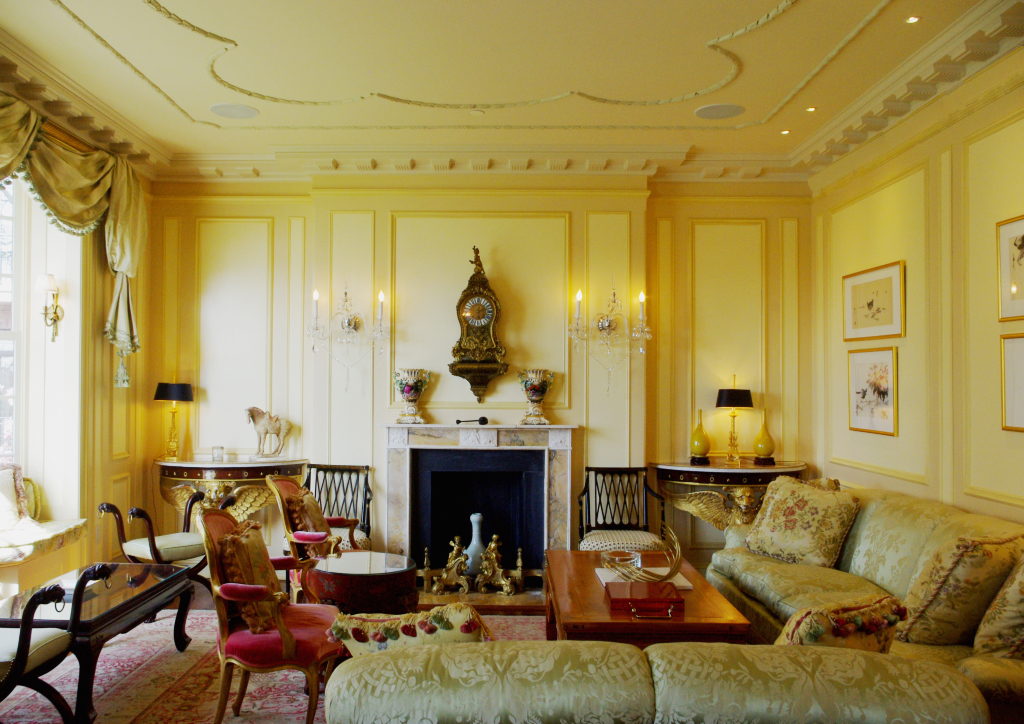

Dragon Scales on the Wall
Major renovations a few years ago added two more floors for her master suite on the fifth level and a rooftop garden on the sixth level. Both floors have a spectacular view of the East River.
A carved Balinese wooden door opens to her foyer where there are six 1800’s Buddhist Monks each holding a ball. The monks are standing on an original black and white 1900’s floor on one side of the foyer, like guardians of the mansion. Two 1600-century Japanese bronze wolves, which supposedly bring good luck, are also in the foyer.
The dining room on the ground floor has an oval mahogany Chinese heritage table that can seat 22 guests. It is surrounded by Ming chairs with an opulent crystal chandelier from France overhead. Nearby is an antique buffet console table.
The walls are hand painted by famous artist Pierre Finkelstein, the detail of which is an enlargement of a scale on the body of the embroidered dragon found on the curtain fabric, which Kan bought in an antique store in Paris. The dining table is decorated with hundreds of little teapots specially designed and hand carved for her by Chinese artisans.
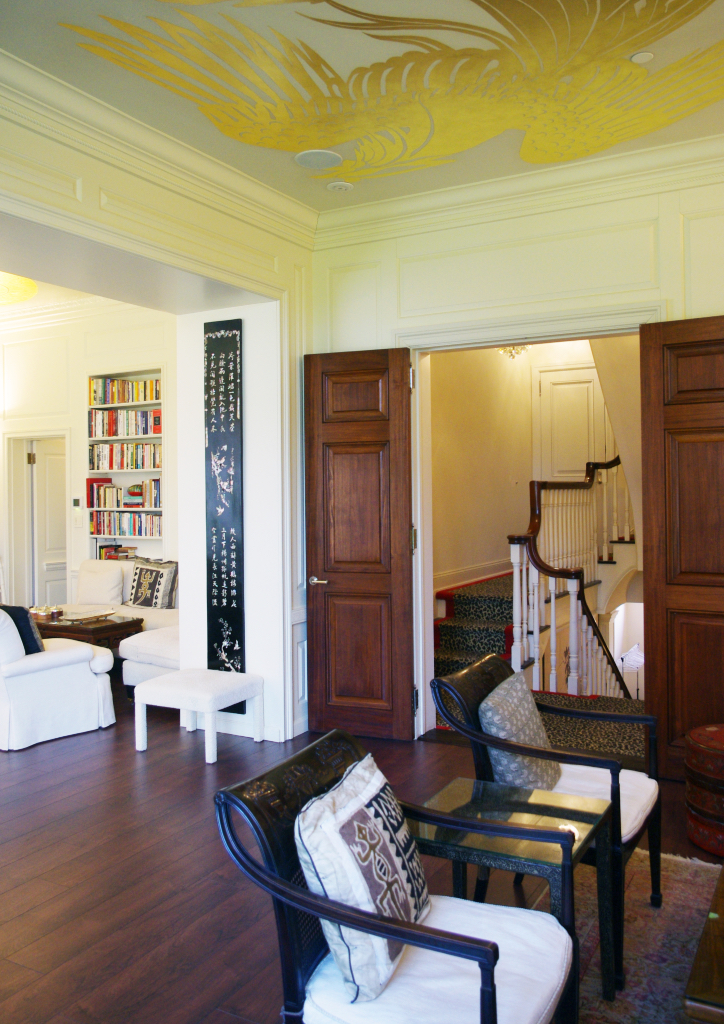
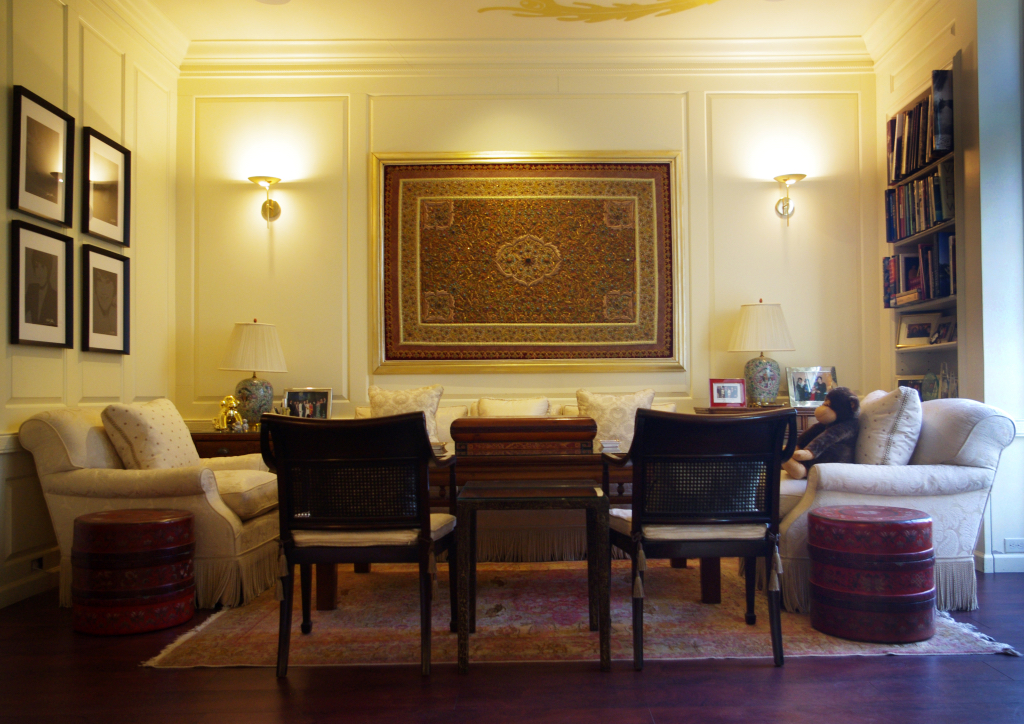
Gold Phoenix in the Ceiling
A winding staircase leads up to all the floors. The second floor has a dramatic ceiling with a dragon and a phoenix hand-painted in gold by Heather Jeltes. Kan uses this room to entertain small groups of guests. There is a jewel encrusted tapestry from Katmandu hanging on one wall and other Asian objets d’art.
The third floor has a formal living area with pieces of period furniture, a silver mirror from India, a 13th-century Cambodian buddha, a 16th-century Myanmar buddha in wood, a Bechstein grand piano from Berlin and a couple of Ming chairs as accent pieces. A French 18th-century clock sits on the mantelpiece over the fireplace. There is portrait of Kan on one wall. Significant art pieces include a water color by her father Kan Wing Lin and an oil painting by Chinese artist Tian Zhi Zong. The room has a European/Asian flair to it.
RELATED READS: “The Real Crazy Rich Asians” As Told by Harper’s Bazaar
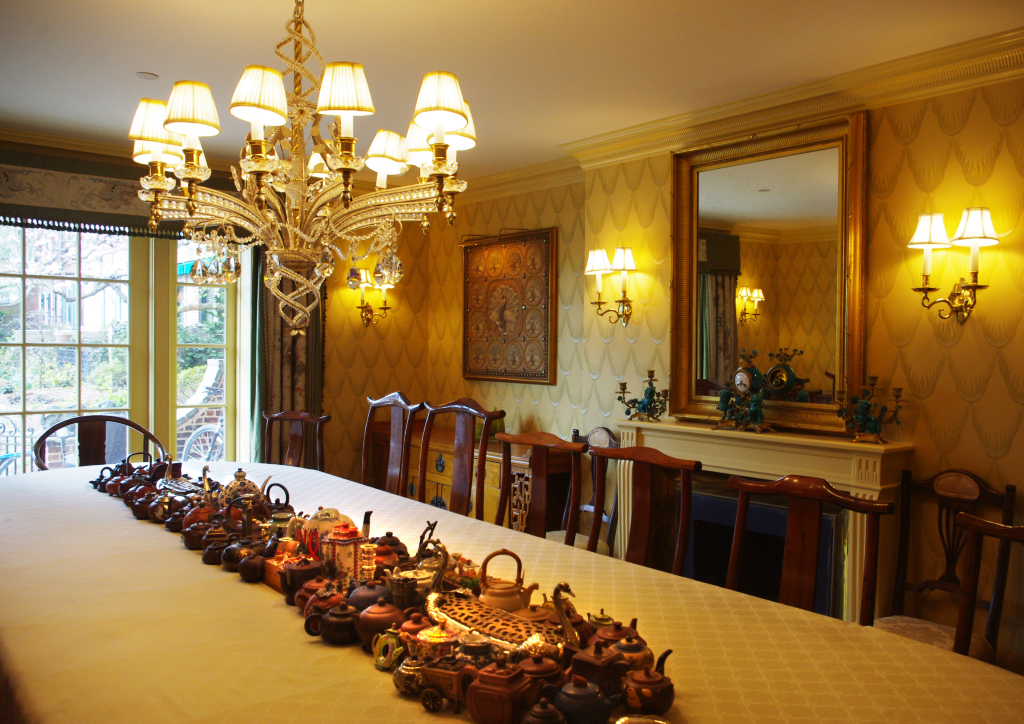
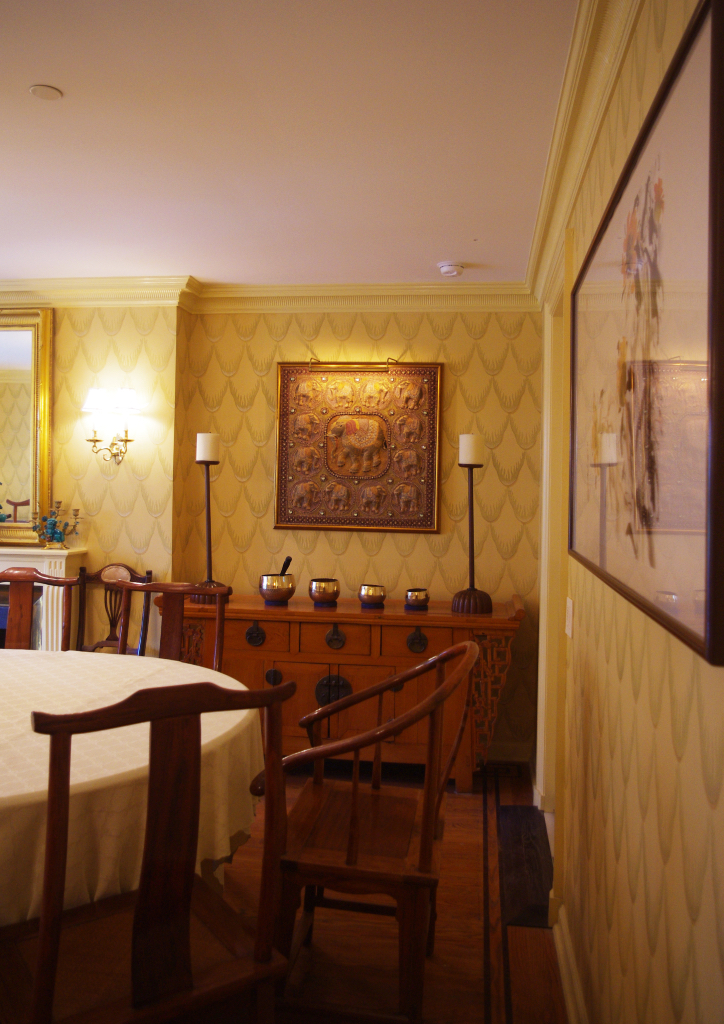
Party Bar on the 3rd, Gym on the 4th
The guest room on the other side of this floor has teal blue walls, a 16th-century chinoisserie secretaire and cabinet, Ming tables and accent chairs. A printed fabric in bright red-orange with shades of green and aqua blue floral dominates the theme of the room. It is used as a bedcover, curtains, pillow covers and lamp shades. The bedroom also has a functional kitchenette in convenient proximity. It serves as the party bar when Kan has dinner parties on this floor.
The fourth floor has a small gym with exercise machines and floor-to-ceiling mirrors. There are two guest rooms next to the gym furnished along contemporary lines.
The master suite on the fifth floor occupies the entire level. It has a huge bedroom with a sitting room, sauna, steam room, whirl pool, bathroom, dressing room and small kitchen.
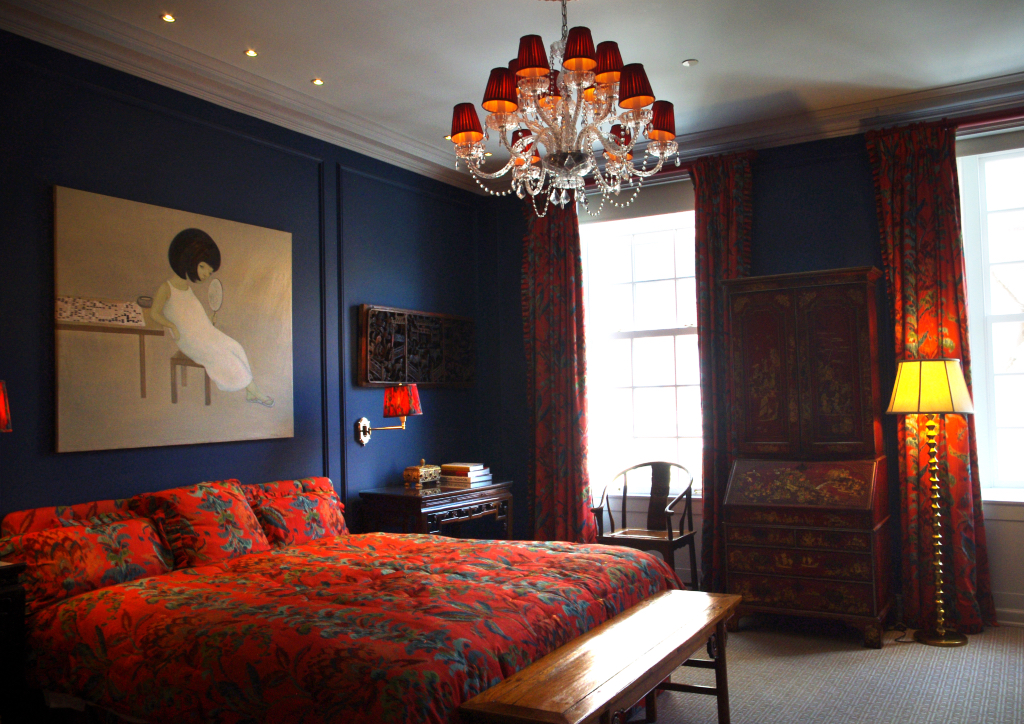
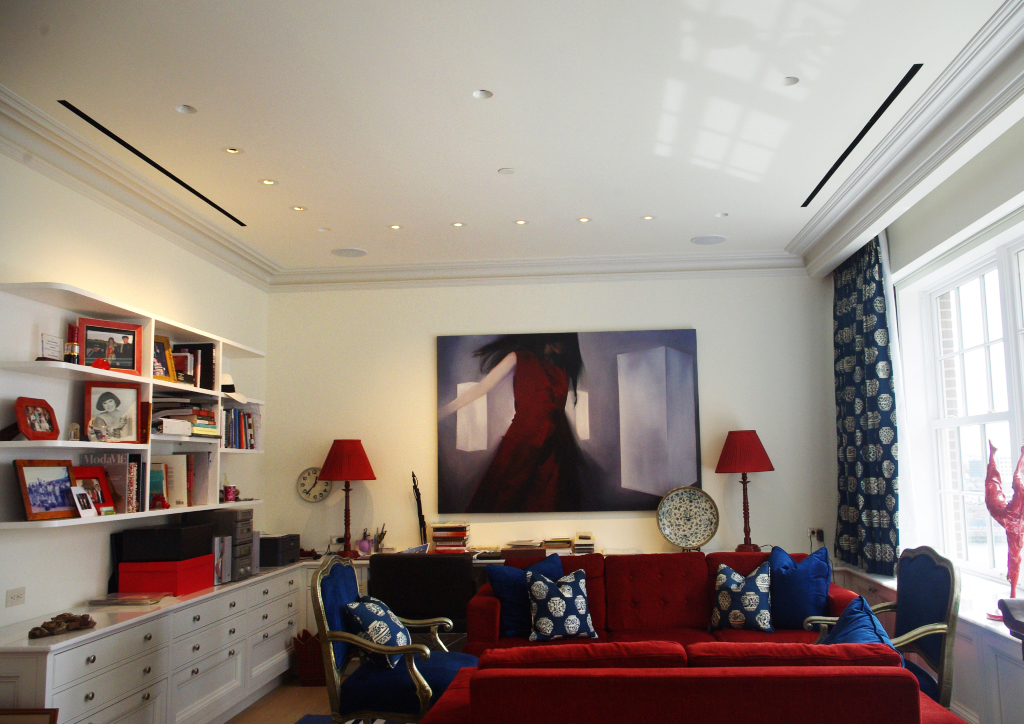
Barbecue Parties on the 6th Floor
A red sofa with blue pillows brighten the sitting room. Asian art and a Dimitar Nikanov sculpture enhance the suite. The walls are enriched by the oil art piece by noted Chinese artist Ku Mu Zi but the more attractive work close to her heart is a large water color by her beloved father, Kan Wing Lin.
The sixth floor has an open terrace where Kan holds barbecue parties. Every floor in this fabulous townhouse has a purpose. The functionality of every floor was carefully planned by Kan to serve her active social lifestyle. “Decorating my homes every now and then gives me lots of energy,” she says.
RELATED READS: 13 of Singapore’s Real Crazy Rich Asians
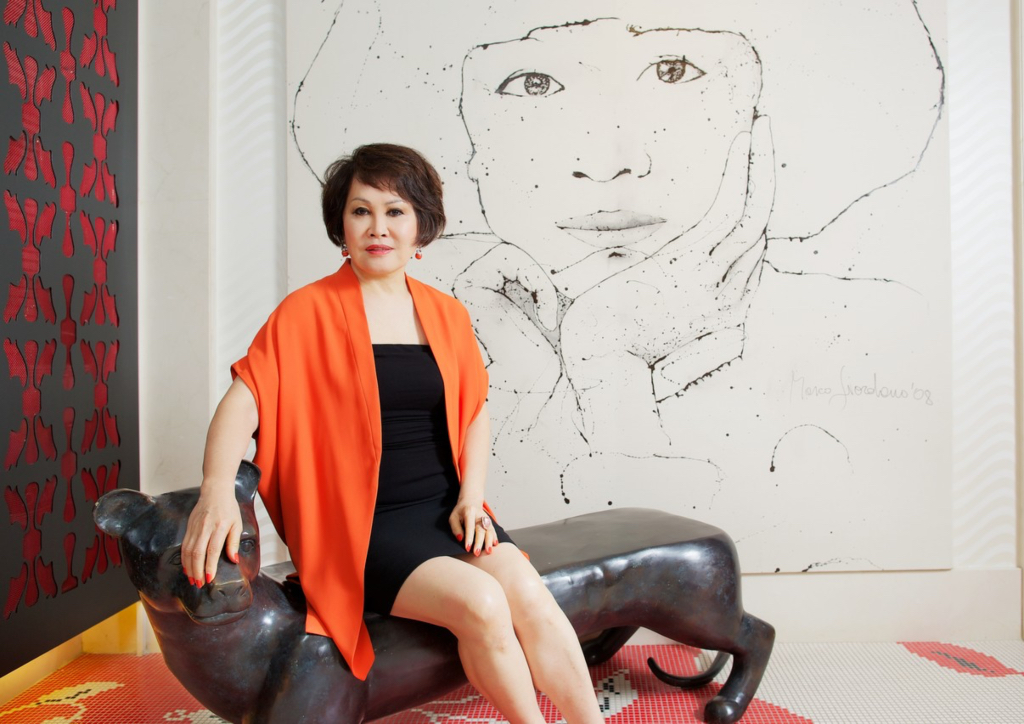
On Yue Sai Kan: The Most Famous Woman in China
People magazine called Yue Sai Kan “the most famous woman in China” and Time magazine called her the “Queen of the Middle Kingdom.” These are well deserved titles for a lady who brought awareness of Chinese culture to the Western world.
In 1984, her TV series One World was watched by 300 million Chinese viewers in the mainland—their first glimpse of the outside world. She captivated the entire nation and the series made her a household name. Broadcasts in both China and the US made her the most watched woman in the world. Chinese women copied her style, her hairdo, her fashion sense. She was every Chinese lady’s aspiration and became their icon.
Making the Twain Meet
One World was followed by Looking East, produced and created by Yue Sai Kan Productions in New York. This was the first program of its kind that introduced Asian customs and cultures to a receptive American audience. The series won many awards and ran for 12 years. The last two years were aired on the Discovery Channel. New York Times said, “Few people are able to bridge the East and the West but Yue Sai Kan can and does it with beauty, intelligence and grace.”
In 1989, the ABC documentary China Walls and Bridges, narrated by Yue Sai Kan herself, won an Emmy Award. Her documentary Journey through a Changing China was syndicated across the country. It was so powerful that it was entered into the United States Congressional Record, which called Ms. Kan “citizen ambassador.”
Ms. Kan, not resting on her laurels, continued to produce a variety of TV shows through the years such as Mini Dragons, Doing Business in China and later Yue Sai’s World and Yue Sai’s Expo, among others. She also started to author books on beauty, success, doing business in China, hygiene, and other topics relevant to the times. Her latest project is an autobiography soon to be released.
Lipstick for Chinese Women
In 1992, the media maven decided to become an entrepreneur. She taught Chinese women how to beautify themselves with Yue Sai Kan Cosmetics. Her company started the cosmetics industry in China and gave Chinese women a better image of themselves. Forbes Magazine reported, “Yue Sai Kan is changing the face of the Middle Kingdom one lipstick at a time.”
The company was sold to L’Oreal, the world’s largest cosmetics company. Kan stayed on as Honorary Vice Chairman of L’Oreal China and through her influence and hard work, made it the most popular brand in China.
On the 10th anniversary of her brand in 2002, YSK was recognized by the Chinese government, putting her face on a postage stamp. She is the only Chinese-American who has ever been given that honor. In 2005, a new version was created to keep up with her new hairdo.
Yue Sai Kan is the franchise holder of Ms. China for Ms. Universe and chairs China Institute’s big October charity event. She mentions in her best seller 99 Inspirations for a Charmed Life being lucky in most of her endeavors and having had the best of life. But other than good fortune, she adds, “Luck is part of a story, but the harder you work, the luckier you get!”
RELATED READS: Senator Loren Legarda on Success and Failure





